初中英语各种时态基本用法介绍
初中英语八大时态结构及用法
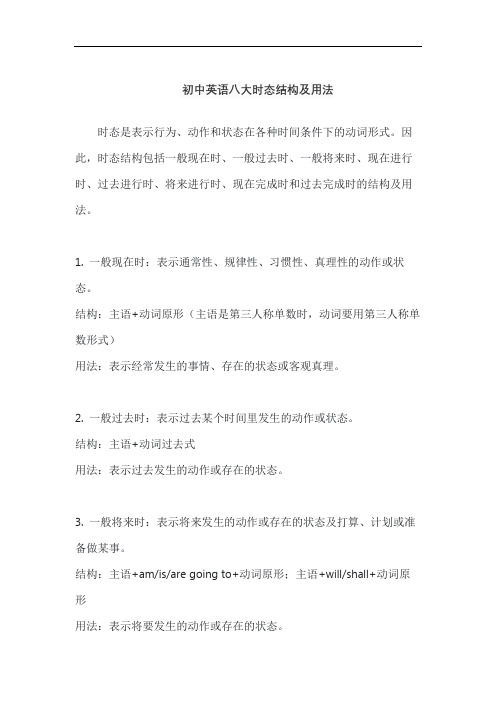
初中英语八大时态结构及用法时态是表示行为、动作和状态在各种时间条件下的动词形式。
因此,时态结构包括一般现在时、一般过去时、一般将来时、现在进行时、过去进行时、将来进行时、现在完成时和过去完成时的结构及用法。
1. 一般现在时:表示通常性、规律性、习惯性、真理性的动作或状态。
结构:主语+动词原形(主语是第三人称单数时,动词要用第三人称单数形式)用法:表示经常发生的事情、存在的状态或客观真理。
2. 一般过去时:表示过去某个时间里发生的动作或状态。
结构:主语+动词过去式用法:表示过去发生的动作或存在的状态。
3. 一般将来时:表示将来发生的动作或存在的状态及打算、计划或准备做某事。
结构:主语+am/is/are going to+动词原形;主语+will/shall+动词原形用法:表示将要发生的动作或存在的状态。
4. 现在进行时:表示现阶段或说话时正在进行的动作及行为。
结构:主语+am/is/are+现在分词用法:表示正在进行的动作。
5. 过去进行时:表示过去某段时间或某一时刻正在发生或进行的动作或行为。
结构:主语+was/were+现在分词用法:表示过去正在进行的动作。
6. 将来进行时:表示将来某一时刻正在进行的动作,或表示要在将来某一时刻开始,并继续下去的动作。
结构:主语+shall/will+be+现在分词用法:表示将来正在进行的动作。
7. 现在完成时:表示过去发生的动作对现在造成的影响或结果,或表示过去的动作或状态持续到现在。
结构:主语+have/has+过去分词用法:表示已经完成的动作或存在的状态。
8. 过去完成时:表示在过去某一时刻或动作以前已经完成了的动作或存在的状态。
结构:主语+had+过去分词用法:表示过去已经完成的动作。
初中英语必考-八大时态结构及用法详解
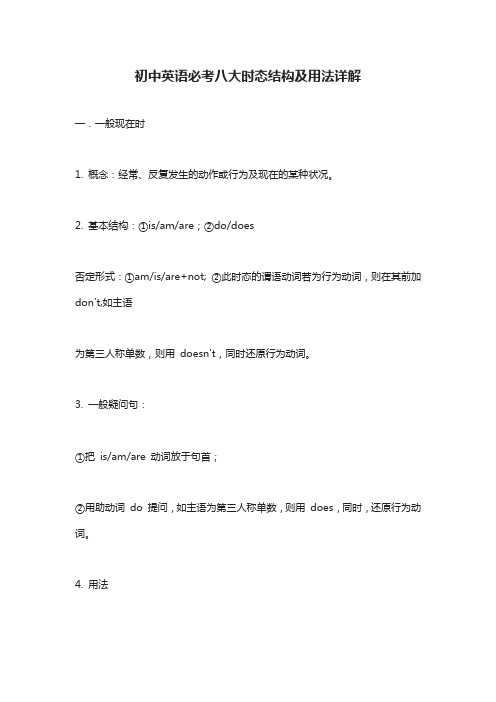
初中英语必考八大时态结构及用法详解一.一般现在时1. 概念:经常、反复发生的动作或行为及现在的某种状况。
2. 基本结构:①is/am/are;②do/does否定形式:①am/is/are+not; ②此时态的谓语动词若为行为动词,则在其前加don't,如主语为第三人称单数,则用doesn't,同时还原行为动词。
3. 一般疑问句:①把is/am/are 动词放于句首;②用助动词do 提问,如主语为第三人称单数,则用does,同时,还原行为动词。
4. 用法1)经常性或习惯性的动作,常与表示频度的时间状语连用。
例如:I leave home for school at 7 every morning. 每天早上我七点离开家。
2)客观真理,客观存在,科学事实。
例如:The earth moves around the sun. 地球绕太阳转动。
Shanghai lies in the east ofChina. 上海位于中国东部。
3)表示格言或警句。
例如:Pride goes before a fall 骄者必败。
注意:此用法如果出现在宾语从句中,即使主句是过去时,从句谓语也要用一般现在时。
例如:Columbus proved that the earth is round. 哥伦布证实了地球是圆的。
4)现在时刻的状态、能力、性格、个性。
例如:I don't want so much. 我不要那么多。
Ann writes good English but does not speak well.安英语写得不错,讲的可不行。
5)一般现在时表示将来含义。
a. 下列动词come, go, arrive, leave, start, begin, return 的一般现在时可以表示将来,主要用来表示在时间上已确定或安排好的事情。
例如:The train leaves at six tomorrow morning. 火车明天上午六点开。
初中英语八种时态详解

初中英语八种时态详解一.一般现在时一.要点提示一般现在时主要用动词原形表示,但是当主语是第三人称单数或者单数名词时,动词的形式要发生变化,其变化规律是:1. 一般动词后加-s, 如:wears, reads, plays, likes, 2.以s, x, ch, sh结尾,后加-es, 如:watches, brushes, 3.以辅音字母+o结尾,一般加-es, 如:goes, does, 4.辅音字母+y 结尾,变y为i,再加-es, 如:worries, carries. Be动词一般现在时的特殊形态是:am, is, are。
Have的第三人称单数是has。
二.用法指南一般现在时的用法1) 表示经常性或习惯性的动作,常与表示频度的时间状语连用。
时间状语:always总是, often经常,usually通常, seldom很少, never从不, sometimes有时(以上频度副词位置放于行为动词之前), every…每…(放于句首或者句末均可)I leave home for school at 7 every morning.It often snows here.2) 表示现在的状态、特征、能力、性格等。
I know him very well.Ann Wang writes good English but does not speak well.3) 表示格言或警句中。
Pride goes before a fall. 骄者必败。
Failure is the mother of success. 失败是成功之母。
4) 表示客观真理,客观存在,科学事实。
The earth moves around the sun.Shanghai lies in the east of China.三. 一般现在时态的肯定形式,否定形式及疑问形式肯定形式是用动词原形,be动词用am, is, are, 注:动词的第三人称单数形式的变化;否定形式是在be动词后加否定词not(缩写成isn’t, aren’t, am与not不能缩写),或者添加助动词do/does加not再加动词原形(缩写成don’t/doesn’t).疑问形式是把be动词或助动词do/does提置句首, 动词还原,句末问号,人称上第一人称变第二人称,第二人称变第一人称,第三人称不变。
初中英语八大时态总结
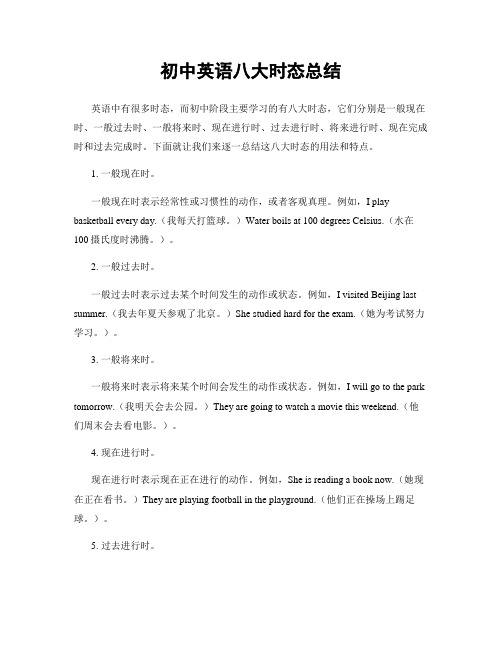
初中英语八大时态总结英语中有很多时态,而初中阶段主要学习的有八大时态,它们分别是一般现在时、一般过去时、一般将来时、现在进行时、过去进行时、将来进行时、现在完成时和过去完成时。
下面就让我们来逐一总结这八大时态的用法和特点。
1. 一般现在时。
一般现在时表示经常性或习惯性的动作,或者客观真理。
例如,I play basketball every day.(我每天打篮球。
)Water boils at 100 degrees Celsius.(水在100摄氏度时沸腾。
)。
2. 一般过去时。
一般过去时表示过去某个时间发生的动作或状态。
例如,I visited Beijing last summer.(我去年夏天参观了北京。
)She studied hard for the exam.(她为考试努力学习。
)。
3. 一般将来时。
一般将来时表示将来某个时间会发生的动作或状态。
例如,I will go to the park tomorrow.(我明天会去公园。
)They are going to watch a movie this weekend.(他们周末会去看电影。
)。
4. 现在进行时。
现在进行时表示现在正在进行的动作。
例如,She is reading a book now.(她现在正在看书。
)They are playing football in the playground.(他们正在操场上踢足球。
)。
5. 过去进行时。
过去进行时表示过去某个时间正在进行的动作。
例如,I was studying when she called me.(她给我打电话的时候,我正在学习。
)They were playing games at that time.(他们那时在玩游戏。
)。
6. 将来进行时。
将来进行时表示将来某个时间正在进行的动作。
例如,I will be having dinner at 7 o'clock tonight.(我今晚7点会在吃晚饭。
初中英语语法时态总结归纳

初中英语语法时态总结归纳英语语法中的时态是指动词在时间上的形式和表达。
在初中英语学习中,时态是一个非常重要的语法知识点。
掌握时态的正确用法对于学习英语语法和提高英语表达能力非常关键。
本文将对初中英语中常见的时态进行总结和归纳,包括一般现在时、一般过去时、一般将来时、现在进行时、过去进行时等。
下面将逐个进行详细介绍。
一、一般现在时一般现在时表示经常性的、习惯性的动作和现在的真理、主张、感觉等。
在一般现在时中,主语是第三人称单数时,动词要加上-s或者-es。
1. 肯定句的结构:主语 + 动词原形(+ -s/-es)例如:- I play basketball.- He reads books every day.2. 否定句的结构:主语 + do not/ does not + 动词原形例如:- I do not play basketball.- He does not read books every day.3. 疑问句的结构:Do/ Does + 主语 + 动词原形?例如:- Do you play basketball?- Does he read books every day?二、一般过去时一般过去时表示在过去某个时间里发生的动作或存在的状态。
在一般过去时中,动词过去式表示过去的时间。
1. 肯定句的结构:主语 + 动词过去式例如:- I played basketball yesterday.- She watched a movie last night.2. 否定句的结构:主语 + did not + 动词原形例如:- I did not play basketball yesterday.- She did not watch a movie last night.3. 疑问句的结构:Did + 主语 + 动词原形?例如:- Did you play basketball yesterday?- Did she watch a movie last night?三、一般将来时一般将来时表示将来某个时间要发生的动作或存在的状态。
初中英语的10种时态及其用法
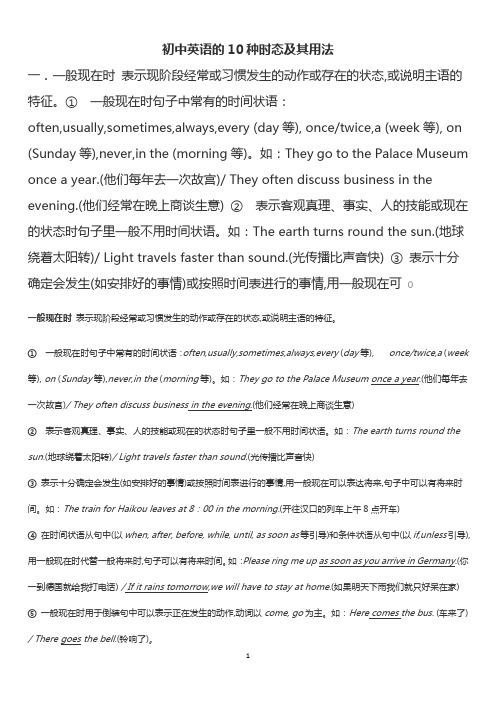
初中英语的10种时态及其用法一.一般现在时表示现阶段经常或习惯发生的动作或存在的状态,或说明主语的特征。
①一般现在时句子中常有的时间状语:often,usually,sometimes,always,every (day等), once/twice,a (week等), on (Sunday等),never,in the (morning等)。
如:They go to the Palace Museum once a year.(他们每年去一次故宫)/ They often discuss business in the evening.(他们经常在晚上商谈生意) ②表示客观真理、事实、人的技能或现在的状态时句子里一般不用时间状语。
如:The earth turns round the sun.(地球绕着太阳转)/ Light travels faster than sound.(光传播比声音快) ③表示十分确定会发生(如安排好的事情)或按照时间表进行的事情,用一般现在可0一般现在时表示现阶段经常或习惯发生的动作或存在的状态,或说明主语的特征。
①一般现在时句子中常有的时间状语:often,usually,sometimes,always,every (day等), once/twice,a (week 等), on (Sunday等),never,in the (morning等)。
如:They go to the Palace Museum once a year.(他们每年去一次故宫)/ They often discuss business in the evening.(他们经常在晚上商谈生意)②表示客观真理、事实、人的技能或现在的状态时句子里一般不用时间状语。
如:The earth turns round the sun.(地球绕着太阳转)/ Light travels faster than sound.(光传播比声音快)③表示十分确定会发生(如安排好的事情)或按照时间表进行的事情,用一般现在可以表达将来,句子中可以有将来时间。
初中英语必考八大时态结构及用法详解
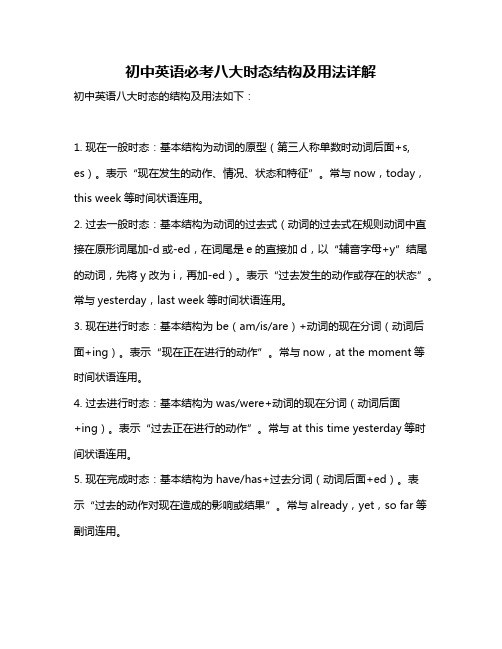
初中英语必考八大时态结构及用法详解初中英语八大时态的结构及用法如下:1. 现在一般时态:基本结构为动词的原型(第三人称单数时动词后面+s, es)。
表示“现在发生的动作、情况、状态和特征”。
常与now,today,this week等时间状语连用。
2. 过去一般时态:基本结构为动词的过去式(动词的过去式在规则动词中直接在原形词尾加-d或-ed,在词尾是e的直接加d,以“辅音字母+y”结尾的动词,先将y改为i,再加-ed)。
表示“过去发生的动作或存在的状态”。
常与yesterday,last week等时间状语连用。
3. 现在进行时态:基本结构为be(am/is/are)+动词的现在分词(动词后面+ing)。
表示“现在正在进行的动作”。
常与now,at the moment等时间状语连用。
4. 过去进行时态:基本结构为was/were+动词的现在分词(动词后面+ing)。
表示“过去正在进行的动作”。
常与at this time yesterday等时间状语连用。
5. 现在完成时态:基本结构为have/has+过去分词(动词后面+ed)。
表示“过去的动作对现在造成的影响或结果”。
常与already,yet,so far等副词连用。
6. 过去完成时态:基本结构为had+过去分词(动词后面+ed)。
表示“过去的动作在过去的某个时间之前已经完成或发生的动作或存在的状态”。
常与by the end of last year,by the time of等时间状语连用。
7. 现在完成进行时态:基本结构为have/has been+动词的现在分词(动词后面+ing)。
表示“动作从过去某时开始,一直延续到现在,或者刚刚完成”。
常与for several days,since等时间状语连用。
8. 过去完成进行时态:基本结构为had been+动词的现在分词(动词后面+ing)。
表示“过去的某个动作从过去某时开始,一直延续到过去的某个时间,或者刚刚完成”。
初中英语语法八种基本时态归纳
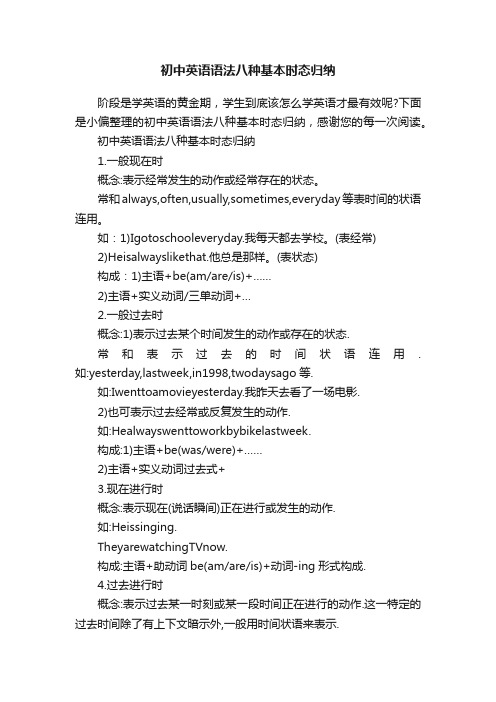
初中英语语法八种基本时态归纳阶段是学英语的黄金期,学生到底该怎么学英语才最有效呢?下面是小偏整理的初中英语语法八种基本时态归纳,感谢您的每一次阅读。
初中英语语法八种基本时态归纳1.一般现在时概念:表示经常发生的动作或经常存在的状态。
常和always,often,usually,sometimes,everyday等表时间的状语连用。
如:1)Igotoschooleveryday.我每天都去学校。
(表经常)2)Heisalwayslikethat.他总是那样。
(表状态)构成:1)主语+be(am/are/is)+……2)主语+实义动词/三单动词+…2.一般过去时概念:1)表示过去某个时间发生的动作或存在的状态.常和表示过去的时间状语连用.如:yesterday,lastweek,in1998,twodaysago等.如:Iwenttoamovieyesterday.我昨天去看了一场电影.2)也可表示过去经常或反复发生的动作.如:Healwayswenttoworkbybikelastweek.构成:1)主语+be(was/were)+……2)主语+实义动词过去式+3.现在进行时概念:表示现在(说话瞬间)正在进行或发生的动作.如:Heissinging.TheyarewatchingTVnow.构成:主语+助动词be(am/are/is)+动词-ing形式构成.4.过去进行时概念:表示过去某一时刻或某一段时间正在进行的动作.这一特定的过去时间除了有上下文暗示外,一般用时间状语来表示.如:1)---Whatwereyoudoing?---Iwasjumping.2)---WhatwastheboydoingwhentheUFOarrived?---Hewassleeping.构成:主语+助动词be(was/were)+动词-ing形式构成.5.一般将来时概念:表示将来某个时间要发生的动作或存在的状态,也表示将来经常或反复发生的动作,常与表示将来的时间状语连用,如:tomorrow,nextweek,nextyear,inthefuture等.如:Hewillgoshoppingtomorrow.Theyaregoingtoplaybasketballnextweek.构成:1)主语+助动词will+动原+…2)主语+begoingto+动原+….6.过去将来时概念:表示在过去将来的某一时间发生的动作或存在的状态.构成:1)主语(第一人称)+助动词should+动原+…2)主语+would+动原+….3)主语+was/weregoingto+动原…用法:过去将来时除了上下文暗示外,一般常用在间接引语中,主句谓语动词为过去时态.如:1)Ishouldgo.2)YouknewIwouldcome.3)TheyweregoingtoNaning.7.现在完成时构成:主语+助动词(have/has)+动词过去分词+…用法例句表示过去发生或已经完成的动作对现在造成的影响或结果.---Haveyouhadyourlunchyet?---Yes,Ihave.(现在我不饿了)8.过去完成时构成:主语+助动词had+动词过去分词+…用法例句表示过去在过去某一时间或动作之前已经发生或完成了的动作.它表示的动作发生的时间是”过去的过去”.表示过去某一时间可用by,before等构成的短语,也可用when,before,等引导的从句或者通过上下文表示.Ihadfinishedmyhomeworkwhenmymomcamebackhome.怎么学英语进步快阶段是学英语的黄金期,小学生到底该怎么学英语才最有效呢?为了家长和孩子们少走弯路,给大家支一招:学英语,从家庭环境的角度,有两个方法非常有效。
初中英语八大时态结构及用法
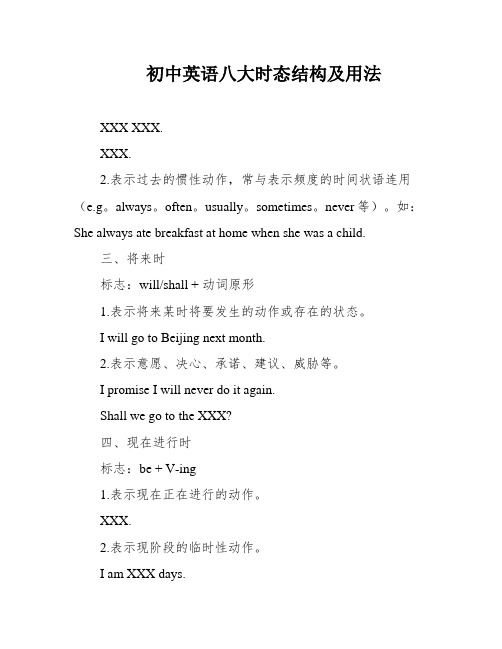
初中英语八大时态结构及用法XXX XXX.XXX.2.表示过去的惯性动作,常与表示频度的时间状语连用(e.g。
always。
often。
usually。
sometimes。
never等)。
如:She always ate breakfast at home when she was a child.三、将来时标志:will/shall + 动词原形1.表示将来某时将要发生的动作或存在的状态。
I will go to Beijing next month.2.表示意愿、决心、承诺、建议、威胁等。
I promise I will never do it again.Shall we go to the XXX?四、现在进行时标志:be + V-ing1.表示现在正在进行的动作。
XXX.2.表示现阶段的临时性动作。
I am XXX days.五、过去进行时标志:was/were + V-ing表示过去某一时刻正在进行的动作。
I was XXX it started to rain.六、现在完成时标志:have/has + 过去分词1.表示过去发生的动作对现在造成的影响或结果。
I have finished my homework。
so I can watch TV now.2.表示动作已经完成,强调完成的结果。
He has written three XXX.七、过去完成时标志:had + 过去分词表示过去某一时刻之前已经完成的动作。
I had XXX XXX.八、将来完成时标志:will have + 过去分词表示将来某一时刻之前已经完成的动作。
By next year。
I will have graduated from university。
时态在英语中是非常重要的语法内容,学好时态基本上就能够掌握语法的大半部分。
英语共有八种时态,分别是一般现在时、一般过去时、将来时、现在进行时、过去进行时、现在完成时、过去完成时和将来完成时。
初中英语八大时态结构及用法

初中英语八大时态结构及用法时态无疑是初中英语最重要的语法内容,学好时态基本就拿下了语法的半壁江山。
英语八大时态:一、一般现在时标志:动词原形1. 表示经常性或习惯性动作,常与表频度的时间状语连用:She often speaks English.I leave home for school at 7 every morning.2. 表示现在的状态、特征、职业、能力、感觉等:He seems to feel a bit down today.He works as a driver.3. 表示真理、客观存在、科学事实或用于格言警句中:Shanghai lies in the east of China.Columbus proved that the earth is round.Where there is a will, there is a way.4. 表示现在瞬间的动作:Here comes the bus!5. 表示将来:1)表按规定、计划、安排将要发生的动作(仅限于某些表示“来、去、动、停、开始、结束、继续”等的趋向动词),可以与表示未来的时间状语搭配使用。
常见的用法是:飞机、火车、轮船、汽车等定期定点运行的交通状况。
如:The next train leaves at 3 o’clock this afternoon.How often does the shuttle bus run?2)在时间和条件状语从句中常使用一般现在时表示将来发生的事情:When Bill comes(不用will come)ask him to wait for me.I shall go there tomorrow unless I’m too busy.二、一般过去时标志:动词过去式闭音节:元音字母a, e, i, o, u如果发字母本来的音则称为开音节,否则称为闭音节。
1. 表示过去某时所发生的动作或存在的状态,常与表示过去的时间状语连用(e.g. yesterday, this morning, just now, a moment ago, in May, last night / year / week, once upon a time, the other day, before …, when …, in the past等)。
(完整版)初中英语八种基本时态总结

初中英语基本时态总结Ⅰ、一般现在时1、概念:1)表示经常性或习惯性的动作,常与表示频度的时间状语连用。
时间状语:always, usually, often, sometimes, seldom, never, every day, twice a week, on Sunday, etc.(提问用How often)例:I leave home for school at 7 every morning.Tom gets up at 6:00 every morning.2)客观真理,客观存在,科学事实。
例:The earth moves around the sun. 地球绕太阳转动。
Shanghai lies in the east of China. 上海位于中国东部。
3)格言或警句。
例:Pride goes before a fall. 骄者必败。
注意:宾语从句中,即使主句是过去时,从句谓语是客观真理也要用一般现在时。
例:Columbus proved that the earth is round. 哥伦布证实了地球是圆的。
2、结构:表状态S+ am/is/are+ P (句中有实义动词不用be)表动作S+V原+O (若主语是单三人称,谓动加s/es。
)3、句式变化:变疑问,有be把be提到主语前;无be在主语前加do/does,谓动变为原形。
变否定,有be在be后加“not”;无be在主语后加don’t/doesn’t,谓动变为原形。
例:①They are in the classroom. →Are they in the classroom? Yes, they are./No, they aren’t. →They aren’t in the classroom②He often waters the flowers . → Does he often water the flowers?Yes, he does. / No, he doesn’t. →He doesn’t often water the flowersⅡ、一般过去时1、概念:1)表示在确定的过去时间里所发生的动作或存在的状态。
初中英语所有时态

初中英语所有时态1.一般现在时(do/does; is/am/are)①表示现在的情况、状态或特征。
例:He is a student.他是一个学生。
②表示经常性、习惯性动作。
例:He always helps others.他总是帮助别人。
③客观事实和普遍真理。
例:The earth moves the sun.地球绕着太阳转。
④表示一个按规定、计划或安排要发生的动作。
仅限于某些表示“来、去、动、停、开始、结束、继续”等的动词,可以与表示未来时间的状语搭配使用。
常见的用法是:飞机、火车、轮船、汽车等定期定点运行的交通方式。
例:The next train leaves at 3 o'clock this afternoon.下一趟火车今天下午3点开车。
⑤在时间、条件和让步状语从句中经常用一般现在(有时也用现在完成时)表示将的来事情。
(即:主将从现原则)例:I will call you as soon as I arrive at the airport.我一到机场就会给你打电话。
When you have finished the report, I will have waited for about 3 hours.等你完成这份报告的时候,我就已经等了将近3个小时了。
2. 现在进行时(am/is/are doing)①表示此时此刻正在发生的事情。
例:He is listning to the music now.他现在正在听音乐。
②表示目前一段时间内一直在做的事情,但不一定此时此刻正在做。
例:I am studying computer this term.这个学期我一直在学习计算机。
③现在进行时可以表示将来的含义。
瞬时动词的进行一定表将来。
例:I am leaving.我要离开了。
持续动词的进行只有有将来的时间状语或有将来语境中才表将来。
例:I am travelling next month.下个月我要去旅行。
初中英语必考八大时态结构及用法详解
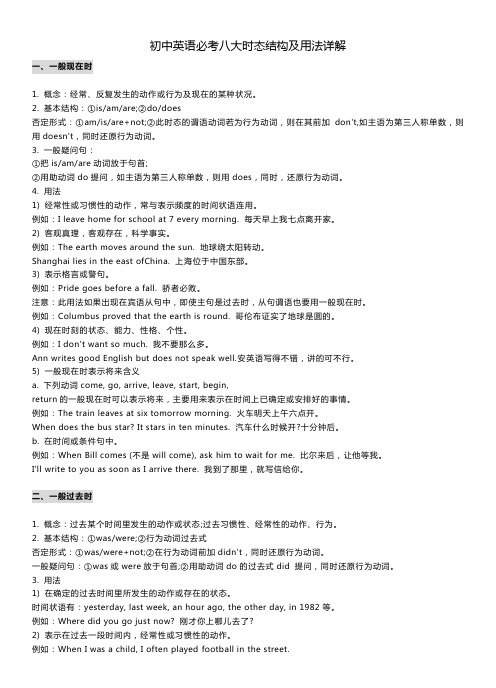
初中英语必考八大时态结构及用法详解一、一般现在时1. 概念:经常、反复发生的动作或行为及现在的某种状况。
2. 基本结构:①is/am/are;②do/does否定形式:①am/is/are+not;②此时态的谓语动词若为行为动词,则在其前加don't,如主语为第三人称单数,则用doesn't,同时还原行为动词。
3. 一般疑问句:①把is/am/are动词放于句首;②用助动词do提问,如主语为第三人称单数,则用does,同时,还原行为动词。
4. 用法1) 经常性或习惯性的动作,常与表示频度的时间状语连用。
例如:I leave home for school at 7 every morning. 每天早上我七点离开家。
2) 客观真理,客观存在,科学事实。
例如:The earth moves around the sun. 地球绕太阳转动。
Shanghai lies in the east ofChina. 上海位于中国东部。
3) 表示格言或警句。
例如:Pride goes before a fall. 骄者必败。
注意:此用法如果出现在宾语从句中,即使主句是过去时,从句谓语也要用一般现在时。
例如:Columbus proved that the earth is round. 哥伦布证实了地球是圆的。
4) 现在时刻的状态、能力、性格、个性。
例如:I don't want so much. 我不要那么多。
Ann writes good English but does not speak well.安英语写得不错,讲的可不行。
5) 一般现在时表示将来含义a. 下列动词come, go, arrive, leave, start, begin,return的一般现在时可以表示将来,主要用来表示在时间上已确定或安排好的事情。
例如:The train leaves at six tomorrow morning. 火车明天上午六点开。
初中英语必考八大时态结构及用法详解
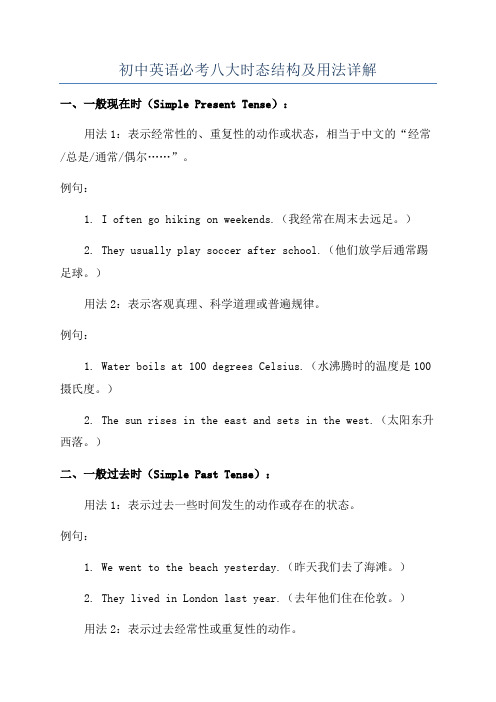
初中英语必考八大时态结构及用法详解一、一般现在时(Simple Present Tense):用法1:表示经常性的、重复性的动作或状态,相当于中文的“经常/总是/通常/偶尔……”。
例句:1. I often go hiking on weekends.(我经常在周末去远足。
)2. They usually play soccer after school.(他们放学后通常踢足球。
)用法2:表示客观真理、科学道理或普遍规律。
例句:1. Water boils at 100 degrees Celsius.(水沸腾时的温度是100摄氏度。
)2. The sun rises in the east and sets in the west.(太阳东升西落。
)二、一般过去时(Simple Past Tense):用法1:表示过去一些时间发生的动作或存在的状态。
例句:1. We went to the beach yesterday.(昨天我们去了海滩。
)2. They lived in London last year.(去年他们住在伦敦。
)用法2:表示过去经常性或重复性的动作。
例句:1. When I was young, I often played hide-and-seek with my friends.(我小时候经常和朋友们玩捉迷藏。
)2. He used to visit his grandparents every summer.(他过去每个夏天都去看望他的祖父母。
)三、一般将来时(Simple Future Tense):用法1:表示将来发生的动作或存在的状态。
例句:1. I will go to the movie tonight.(今晚我将去看电影。
)2. She is going to visit her grandparents next month.(她下个月打算去看望她的祖父母。
初中英语8大时态结构及用法,赶快收藏!

初中英语8大时态结构及用法,赶快收藏!时态无疑是初中英语最重要的语法内容,学好时态基本就拿下了语法的半壁江山。
今天总结的八种时态是大家在初中阶段必学必考的,复习时一定要加倍重视哦!一、一般现在时1、概念:表示经常发生的情况;有规律出现的情况;总是发生的;和事实真理。
2.时间状语: Always, usually, often, sometimes, every week (day, year, month…), once a week (day, year, month…), on Sundays (on Mondays…)3.基本结构:动词原形(如主语为第三人称单数,动词上要改为第三人称单数形式)4.否定形式:主语+am / is / are+not+其他;此时态的谓语动词若为行为动词,则在其前加don't,如主语为第三人称单数,则用doesn't,同时还原行为动词。
5.一般疑问句:把be动词放于句首;用助动词do提问,如主语为第三人称单数,则用does,同时,还原行为动词。
eg:①It seldom snows here.这里很少下雪。
②He is always ready to help others.他总是乐于帮助别人。
③Action speaks louder than words.事实胜雄辩。
二、一般过去时1.概念:过去某个时间里发生的动作或状态;过去习惯性、经常性的动作、行为。
2.时间状语:ago, yesterday, the day before yesterday, last week, last (year,ni ght,month…), in 1989, just now, at the age of 5, one day, long long ago, once upon a time,etc.3.基本结构:主语+动词的过去式或 be 的过去式+名词4.否定形式:主语+was / were+not+其他;在行为动词前加didn't,同时还原行为动词。
初中英语时态总结
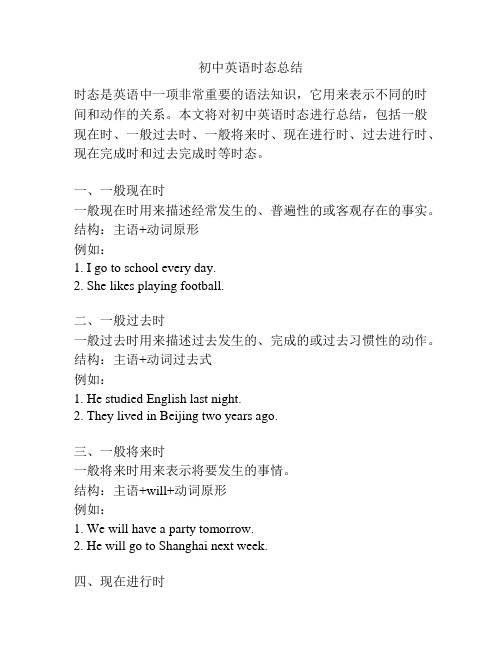
初中英语时态总结时态是英语中一项非常重要的语法知识,它用来表示不同的时间和动作的关系。
本文将对初中英语时态进行总结,包括一般现在时、一般过去时、一般将来时、现在进行时、过去进行时、现在完成时和过去完成时等时态。
一、一般现在时一般现在时用来描述经常发生的、普遍性的或客观存在的事实。
结构:主语+动词原形例如:1. I go to school every day.2. She likes playing football.二、一般过去时一般过去时用来描述过去发生的、完成的或过去习惯性的动作。
结构:主语+动词过去式例如:1. He studied English last night.2. They lived in Beijing two years ago.三、一般将来时一般将来时用来表示将要发生的事情。
结构:主语+will+动词原形例如:1. We will have a party tomorrow.2. He will go to Shanghai next week.四、现在进行时现在进行时用来描述现在正在进行的动作或状态。
结构:主语+be(am, is, are)+动词-ing例如:1. She is studying for the test now.2. They are playing basketball in the park.五、过去进行时过去进行时用来描述过去某个时间正在进行的动作。
结构:主语+was/were+动词-ing例如:1. I was studying when she called me.2. They were cooking dinner at 7 o'clock yesterday.六、现在完成时现在完成时用来表示过去发生的动作对现在造成的影响或与现在相关的动作。
结构:主语+have/has+动词过去分词例如:1. He has finished his homework.2. We have visited the Great Wall.七、过去完成时过去完成时用来表示过去某个时间或动作之前已经完成的动作。
初中英语时态用法详解
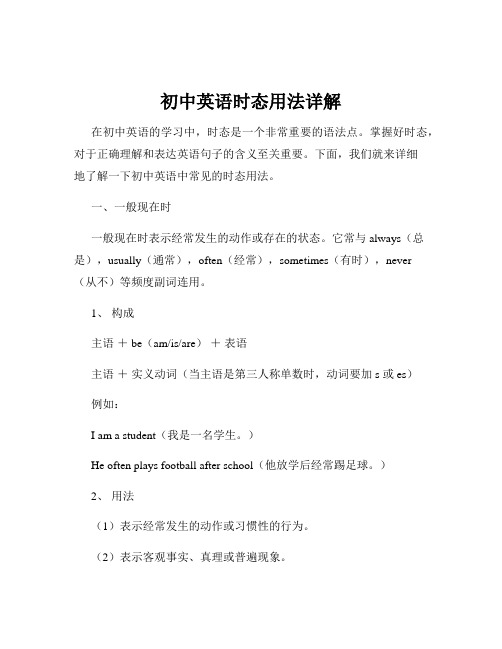
初中英语时态用法详解在初中英语的学习中,时态是一个非常重要的语法点。
掌握好时态,对于正确理解和表达英语句子的含义至关重要。
下面,我们就来详细地了解一下初中英语中常见的时态用法。
一、一般现在时一般现在时表示经常发生的动作或存在的状态。
它常与 always(总是),usually(通常),often(经常),sometimes(有时),never(从不)等频度副词连用。
1、构成主语+ be(am/is/are)+表语主语+实义动词(当主语是第三人称单数时,动词要加 s 或 es)例如:I am a student(我是一名学生。
)He often plays football after school(他放学后经常踢足球。
)2、用法(1)表示经常发生的动作或习惯性的行为。
(2)表示客观事实、真理或普遍现象。
(3)在时间、条件状语从句中,用一般现在时表示将来。
二、一般过去时一般过去时表示过去某个时间发生的动作或存在的状态。
1、构成主语+ be(was/were)+表语主语+实义动词的过去式例如:I was at home yesterday(昨天我在家。
)She went to Beijing last year(她去年去了北京。
)2、用法(1)表示过去发生的动作或存在的状态。
(2)表示过去经常或反复发生的动作。
三、一般将来时一般将来时表示将来要发生的动作或存在的状态。
1、构成(1)will +动词原形(2)be going to +动词原形I will go to the zoo tomorrow(明天我将去动物园。
)They are going to have a party next week(他们下周将举行一个聚会。
)2、用法(1)表示将来要发生的动作或存在的状态。
(2)表示计划、打算做某事。
四、现在进行时现在进行时表示现在正在进行的动作。
1、构成主语+ be(am/is/are)+现在分词例如:They are playing basketball now(他们现在正在打篮球。
- 1、下载文档前请自行甄别文档内容的完整性,平台不提供额外的编辑、内容补充、找答案等附加服务。
- 2、"仅部分预览"的文档,不可在线预览部分如存在完整性等问题,可反馈申请退款(可完整预览的文档不适用该条件!)。
- 3、如文档侵犯您的权益,请联系客服反馈,我们会尽快为您处理(人工客服工作时间:9:00-18:30)。
初中英语六大时态基本用法介绍
一般现在时
一、定义1.表示事物或人物的特征、状态。
如:The sky is blue.天空是蓝色的。
2.表示经常性或习惯性的动作。
如:I get up at six every day.我每天六点起床。
3.表示客观现实。
如:The earth goes around the sun.地球绕着太阳转。
二、时间状语:
Always, usually, often, sometimes, every week (day, year, month…), once a week(day, year, month…), on Sundays,
三、基本结构:动词原形(如主语为第三人称单数,动词上要改为第三人称单数形式)否定形式:主语+am/is/are +not+其他; 此时态的谓语动词若为行为动词,则在其前加don't, 如主语为第三人称单数,则用doesn't,同时还原行为动词。
一般疑问句:把be动词放于句首;用助动词do提问,如主语为第三人称单数,则用does,同时,还原行为动词一般现在时的变化
特殊疑问句:疑问词+一般疑问句。
如:How does your father go to work?
例句:It seldom snows here.
He is always ready to help others.
Action speaks louder than words..
动词+s的变化规则
1.一般情况下,直接加-s,如:cook-cooks, milk-milks
2.以s. x. sh. ch. o结尾,加-es,如:guess-guesses, wash-washes, watch-watches
3.以“辅音字母+y”结尾,变y为i, 再加-es,如:study-studies
一般过去时
一、定义:过去某个时间里发生的动作或状态;过去习惯性、经常性的动作、行为。
二、时间状语:
ago, yesterday, the day before yesterday, last week, last(year, night, month…), in 1989, just n ow, at the age of 5, one day, long long ago, once upon a time, etc.
三、基本结构:be动词;行为动词的过去式
否定形式:主语+was/were +not+其他;在行为动词前加didn't,同时还原行为动词。
5.一般疑问句:was或were放于句首;用助动词do的过去式did 提问,同时还原行为动词。
例句:She often came to help us in those days.
I didn't know you were so busy.
动词过去式变化规则:
1.一般在动词末尾加-ed,如:pull-pulled, cook-cooked
2.以e结尾的直接加d,如:taste-tasted
3.辅+元+辅结尾的双写词尾的辅音字母再加ed,如:stop-stopped
4.以“辅音字母+y”结尾的,变y为i,再加-ed,如:study-studied
5.不规则变化:
am, is-was, are-were, do-did, see-saw, say-said, give-gave, get-got, go-went, come-came, hav e-had, eat-ate, take-took, run-ran, sing-sang, put-put, make-made, read-read, write-wrote, dra w-drew, drink-drank, fly-flew, ride-rode, speak-spoke, sweep-swept, swim-swam, sit-sat
现在进行时
1.概念:表示现阶段或说话时正在进行的动作及行为。
2.时间状语:Now, at this time, days, etc. look. listen
3.基本结构:主语+be +doing +其他
否定形式:主语+be +not +doing+其他
一般疑问句:把be动词放于句首。
例句: How are you feeling today?
He is doing well in his lessons
动词加ing的变化规则
1.一般情况下,直接加ing,如:cook-cooking
2.以不发音的e结尾,去e加ing,如:make-making, taste-tasting
3.如果末尾是一个元音字母和一个辅音字母,双写末尾的辅音字母,再加ing,如:run-running, stop-stopping
一般将来时
1.概念:表示将要发生的动作或存在的状态及打算、计划或准备做某事。
2.时间状语:
Tomorrow, next day(week, month, year…),soon, in a few minutes, by…,the day after tomorr ow, etc.
3.基本结构:主语+am/is/are +going to + do+其他;主语+will/shall + do+其他
主+be +v.ing+其它, 此类常为移位动词。
如:go,come ,leave,arrive,move,leave for,fly(飞), take off,(起飞)set off,drive等
否定形式:主语+am/is/are not going to do ;主语+will not do+其他
一般疑问句:be放于句首;will提到句首。
例句:They are going to have a competition with us in studies. It is going to rain.
用来be going to表示按计划或安排要发生的动作,有“准备;打算”的意思。
这种主观意图,一般已做过事先安排,故其实现的可能性较大。
We are going to have a class meeting this afternoon.今天下午我们打算开班会。
Will强调客观情况I will be 18 years old next year. It will be sunny tomorrow.
4. 使用be going to 应注意的两点
a.There be 句型的be going to 结构为:There is / are going to be... (注意句型中
going to 后面的be不能改为have。
) 常用来表示将有某事发生。
例如:
There is going to be a football match next Saturday in our school. 下周六我们学校将有一场足球比赛。
e, go, leave, arrive等表示位置移动的动词常用现在进行时表示将要发生的动
作,它们很少与be going to 结构连用。
例如: Miss Sun is coming tonight.今晚孙小姐要来。
现在完成时
1.概念:过去发生或已经完成的动作对现在造成的影响或结果,或从过去已经开始,持续到现在的动作或状态。
2.时间状语:yet,already,just,never,ever,so far,by now,since+时间点,for+时间段,recently, lately, in the past few years, etc.
3.基本结构:主语+have/has +p.p(过去分词)+其他
否定形式:主语+have/has + not +p.p(过去分词)+其他
一般疑问句:have或has 提前
例句:I've written an article.
The countryside has changed a lot in the past few years.
过去进行时
1.概念:表示过去某段时间或某一时刻正在发生或进行的行为或动作。
2.时间状语:at this time yesterday, at that time或以when引导的谓语动词是一般过去时的时间状语等。
3.基本结构主语+was/were +doing +其他
否定形式:主语+was/were + not +doing+其他
一般疑问句:把was或were放于句首。
(第一个字母大写)
例句:
At that time she was working in a PLA unit. When he came in, I was reading a newspaper.。
